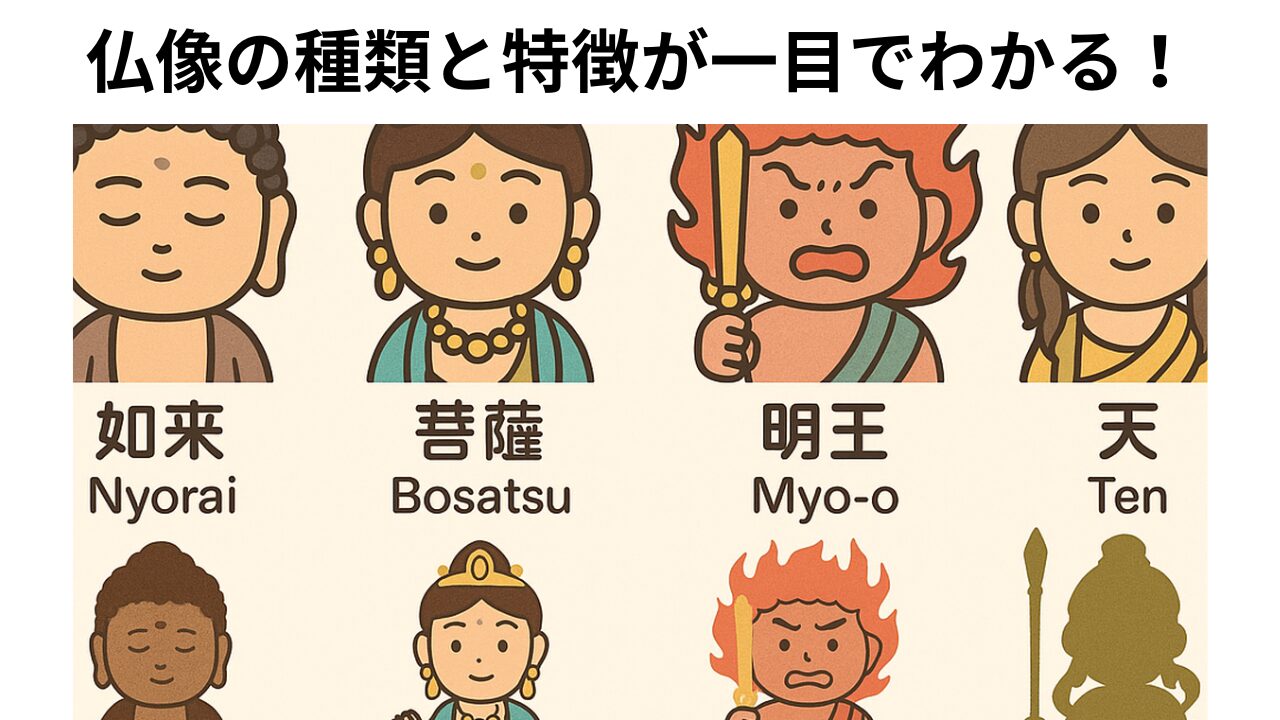仏像には大きく分けて 4種類――如来(にょらい)、菩薩(ぼさつ)、明王(みょうおう)、天部(てんぶ)があります。それぞれ姿も意味も違うため、見分け方を知ると、仏像旅がぐっと楽しく、深くなります。
この記事では、これら4つのタイプをやさしい言葉で解説。
代表的な見た目の特徴や意味、初心者でもわかりやすい見分け方のポイントをまとめました。
仏像がもっと身近に感じられますように。
仏像にはどんな種類があるの?
日本の仏像は、主に以下の4タイプに分けられます。服装・表情・持ち物・ポーズなどで見分けられるので、少し知るだけで拝観がより楽しくなります。
- 1. 如来(Nyorai):悟りを開いた完成した仏さま
- 2. 菩薩(Bosatsu):人々の救いを願うやさしい仏さま
- 3. 明王(Myo-o/Wisdom King):怒りの力で迷いや災いを断つ仏さま
- 4. 天部(Ten/Deity):仏教を守り、福をもたらす神々
それぞれの特徴を順に紹介します。
1. 如来(にょらい) — 悟りを開いた存在
苦しみを乗りこえて幸せに暮らすための方法、つまり“仏教”を広めるほとけさま
- 意味:修行を終え、「悟り」に到達した完成された仏。
- 見た目の特徴:派手な装飾はなく、シンプルで落ち着いた服装。たいていは一枚の法衣のみ。
- 装飾はタブー:悟りを得た如来に、世俗の飾りは必要ありません。ただし、密教の大日如来のように例外もあります。
- あたま…知恵がたくさん詰まっているので、頭のてっぺんがボコッと盛り上がっています(肉髻 にっけい)。そして、たくさんのぶつぶつ(螺髪 らほつ)は髪の毛です。長い髪の毛が1本ずつくるくると丸まり、こうした形になっています。
- 手の形や姿勢:多くの如来像は「印相(いんそう)」と呼ばれる手の形を持ち、それぞれ意味があります。
- 代表例:阿弥陀仏、釈迦如来、薬師如来、大日如来など。
シンプルな姿だからこそ、その静けさと荘厳さは、見る人の心を落ち着かせてくれます。
◎如来のモデルになったのは、約2500年前にインドで仏教を始めたお釈迦さまです。お釈迦さまは、6年も厳しい修行を積み、やがて人間からほとけさまに変わりました。その姿をもとに、如来の形が生まれました。
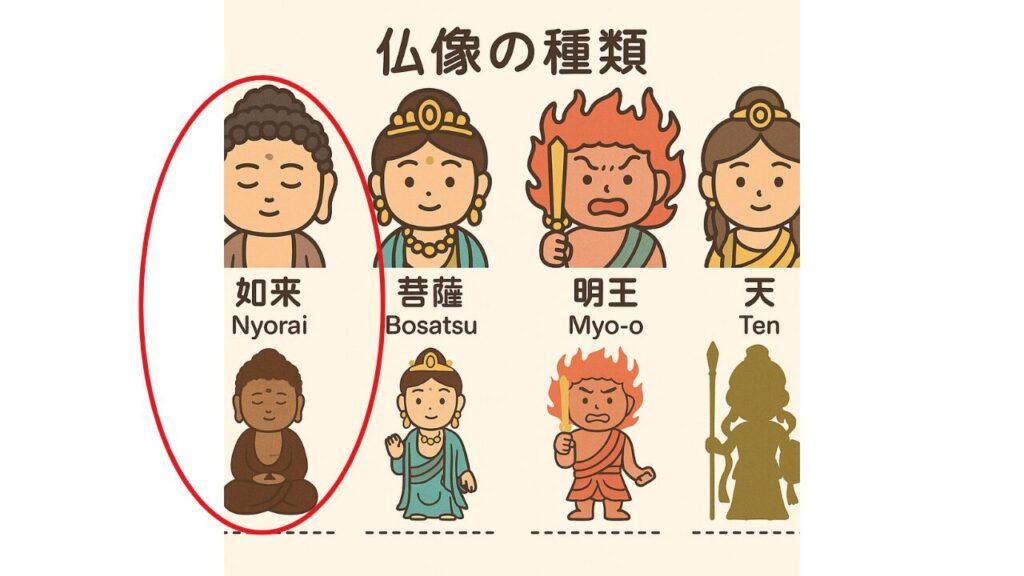
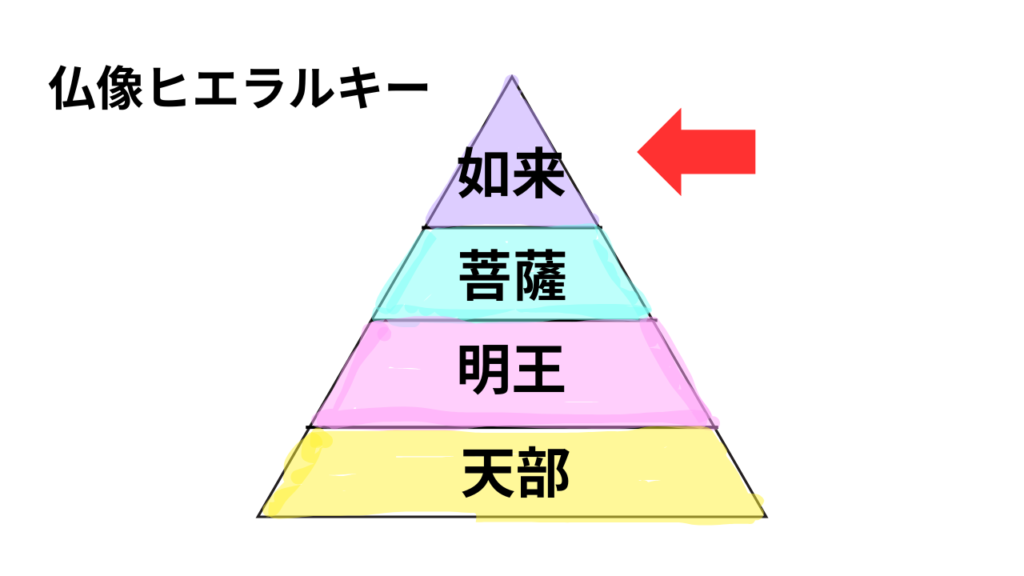
如来(にょらい)について、もっと詳しく知りたい方はこちらの記事もぜひご覧ください。
▶︎如来とは?釈迦如来・薬師如来・阿弥陀如来・大日如来の違い
2. 菩薩(ぼさつ) — 人々に寄り添う救いの仏
人々に寄り添い、さまざまな願いに応えるほとけさま
- 意味:まだ悟りを得る前にありながら、「自分だけでなく人々の救い」を願う仏さま。
- 見た目の特徴:首や腕、手首などにアクセサリーを着けています。昔のインド王子の姿がモデルになっているので、豪華なファッションをしています。
- 表情:おだやかな表情は、菩薩の特徴のひとつ。人びとを優しく見守っています。
- 姿勢や持ち物:「蓮の花」「珠(たま)」「数珠」などを持つことが多く、優美で慈悲深い雰囲気。
- ハスの花:如来や菩薩などのほとけ様は、ハスの花から生まれてきたと考えられてきました。そのため、菩薩はハスの花にのった姿でよく表されています。
- 代表例:観音菩薩、文殊菩薩、勢至菩薩、地蔵菩薩など。
菩薩像はその装飾と表情の豊かさで、祈りや願いに寄り添ってくれるように感じられます。
◎菩薩のモデルはお釈迦さまです。修行を始める前、お釈迦さまはインドの小さな国の王子でした。その姿をモデルに、まず観音菩薩の形が作られます。その後に、人びとの願いに合わせて、様々な菩薩が登場しました。
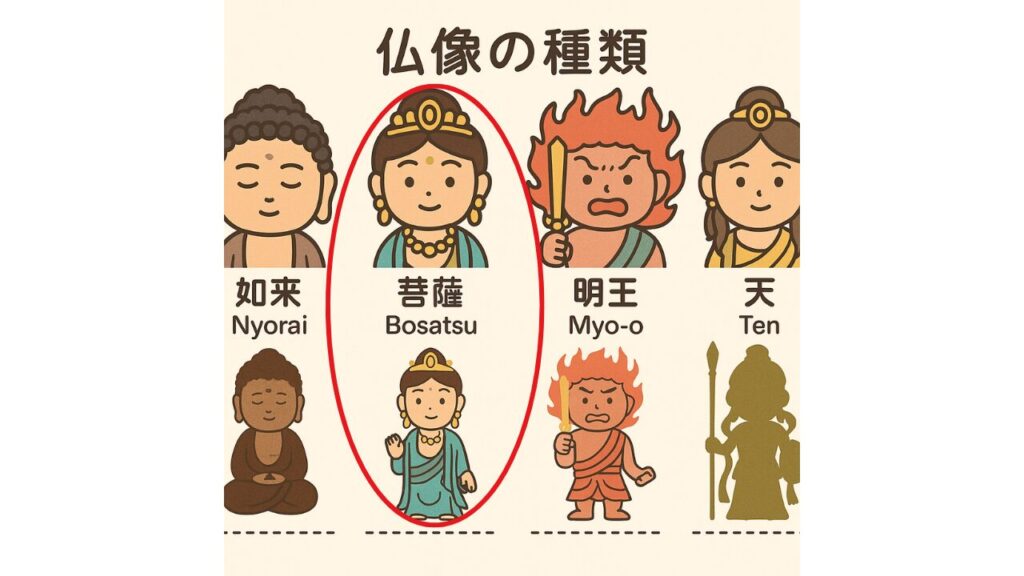
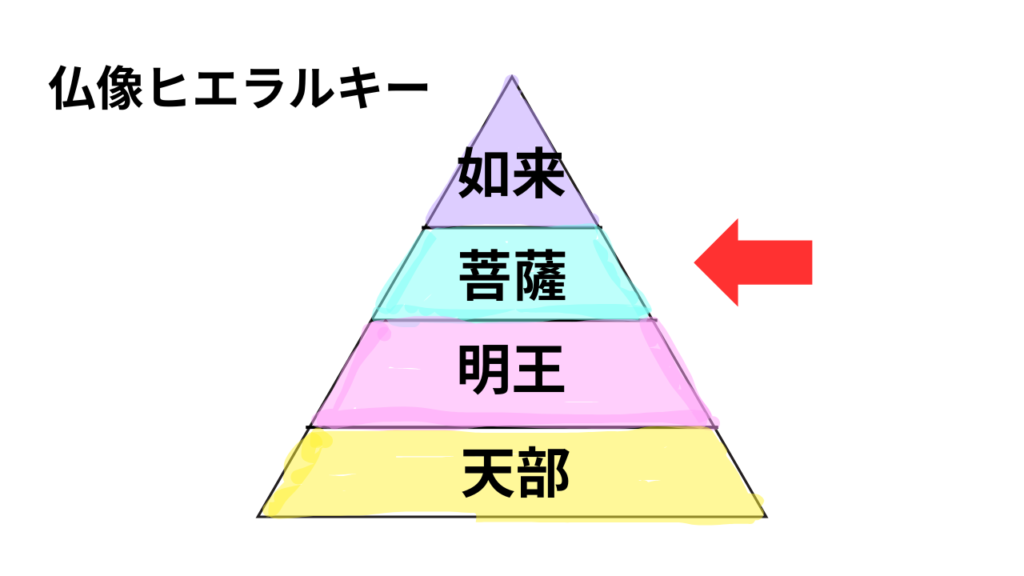
菩薩(ぼさつ)について、もっと詳しく知りたい方はこちらの記事もぜひご覧ください。
▶︎菩薩とは?|その意味や如来との違い、仏像の魅力をやさしく解説
3. 明王(みょうおう) — 怒りの形で人々を導く守護神
悪いことをする人々を正しい方向へ導いたり、様々な悪や災いを打ち消したりするほとけさま
- 意味:仏教の教えに背く者、迷いや災いをはらうために、あえて「怒り」や「恐ろしさ」を持つ仏さま。
- 表情:ほとんどの明王が、牙をむいた憤怒の顔をしています。ほとけさまの教えに従わない人びとを怒っているのだそうです。
- 見た目の特徴:炎を背にし、武器を持つことが多い。表情も体つきも力強く、見た目の迫力があります。
- 服装:基本的には、菩薩と似ていて、上半身に条帛、下半身に裳をまとうスタイル。たまに獣の皮をまとった明王もいます。
- 象徴:剣や羂索(けんさく)、金剛杵(こんごうしょ)などを持ち、煩悩や悪を断ち切る力をもつとされます。
- 宝剣が象徴:剣の力によって魔物を降伏させ、仏教の世界に引き入れます。特に不動明王には欠かせない武器です。
- 代表例:不動明王、降三世明王、軍荼利明王など。
明王像を目の当たりにすると、「守られている」「心が清められる」というような強い安心感を覚える人も少なくありません。
◎明王は、さまざまな悪や災いを打ち消すことができるほどの、とても強いパワーをもっています。強い力を持っていることを表すために、怒った表情をし、燃え盛る炎のオーラをまとうなど、恐ろしい姿をしています。
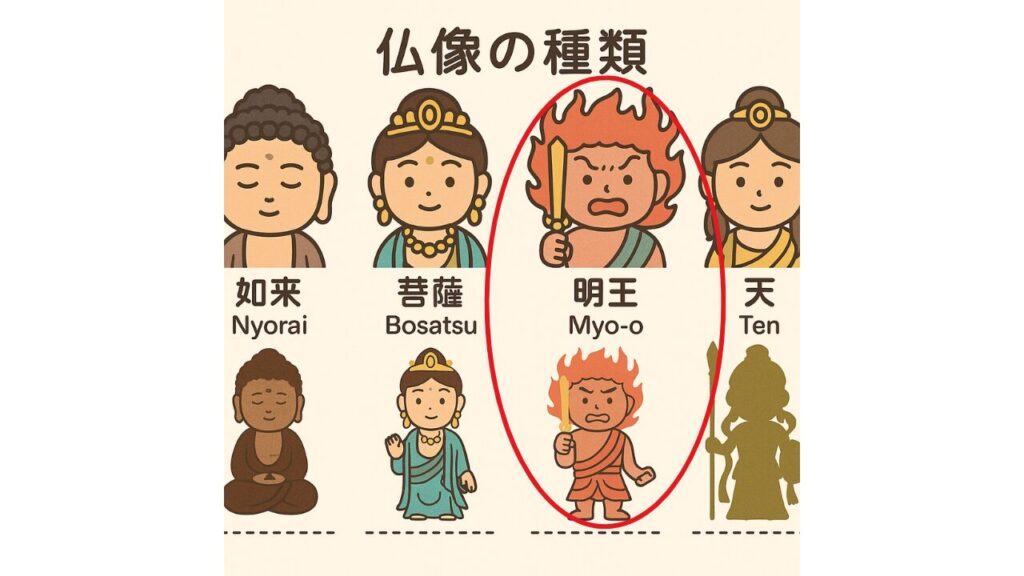
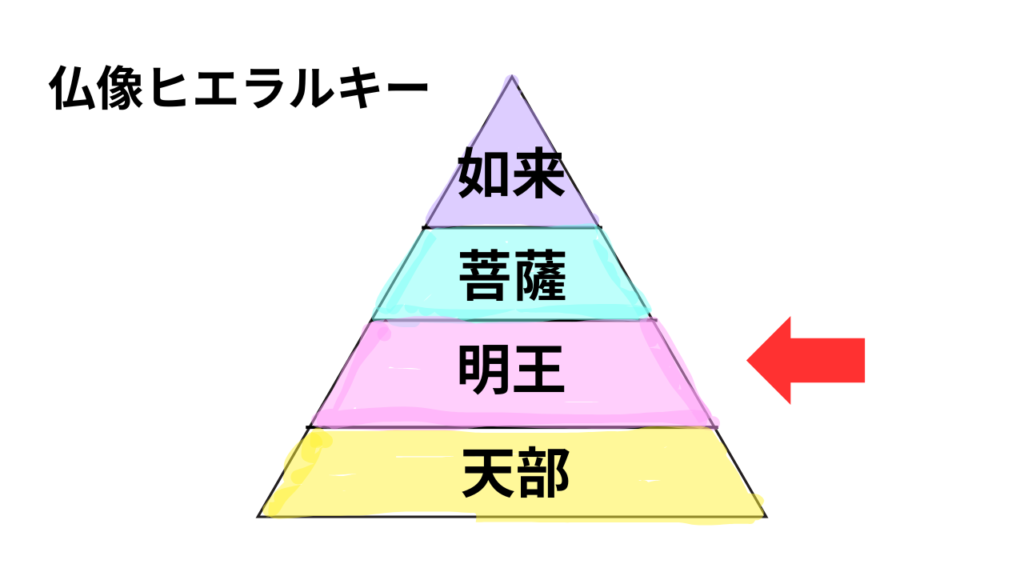
明王(みょうおう)について、もっと詳しく知りたい方はこちらの記事もぜひご覧ください。
▶︎明王とは?|その意味・特徴・魅力をやさしく解説
4. 天部(てんぶ) — 仏教を守り、福をもたらす神々
仏教の世界や仏教を信じる人びとを守ったり、人びとに福を授けたりするほとけさま
- 意味:もともとは異教の神々であったものが、仏教の守護神となった存在たち。仏教の世界や人々を守る役割を担います。
- 見た目の特徴:武人風、天女風、鬼神風など、さまざまなスタイルがあります。武具を持つ、鎧を身につける、靴を履くなど、人間に近い姿が多いのが特徴。
- 持ち物・装飾:武器、宝珠、楽器など、その神格や役割に応じたアイテムを持つことが多いです。
- 武人系:甲冑:ほとけ様の世界を守るガードマンの役割を担う天もいます。甲冑を着けた姿か、上半身が裸で筋肉もりもりの姿をしています。
- 武人系:邪気を踏む:岩に乗るパターンが一般的ですが、四天王はたいてい、仏教の敵である邪気を踏みつけています。
- 天女系:服装:中国風の着物を着ているなど、菩薩にも負けないおしゃれ好き。鎧の上に袈裟をまとうなど重ね着も上手です。
- 天女系:蓮華座に乗る:天女系は多くの仏さまと同じくハスの花をかたどった蓮華座に乗るのが一般的です。
- 他にも:袖口の広い服を着たり、ズボン(袴)や靴を履いたりしていうのは天だけ。こうした服装は、主に中国や日本で生み出されました。
- 代表例:毘沙門天(武人系)、弁財天・吉祥天(天女系)、帝釈天・梵天 など。
天部像は「仏教の守り」「福をもたらす存在」として、見る人に安心と希望を与えてくれます。
◎かつてインドの神さまで、やがてほとけさまに仲間入りしたグループです。天の形が様々なのは、いろんな姿の神さまがいたから、また色々な国や地域の信仰と結びつき、姿を変えてきたからだそうです。
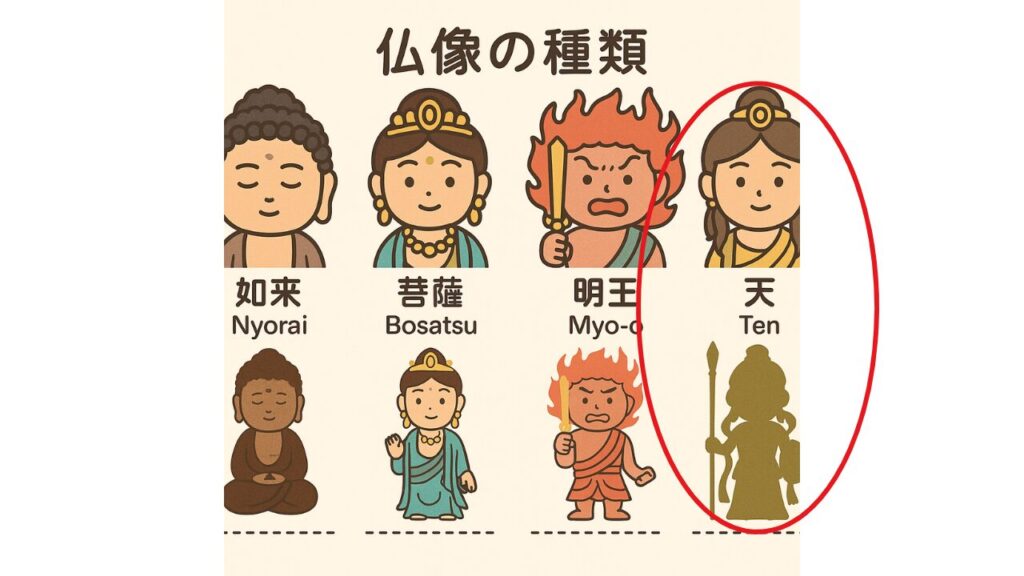
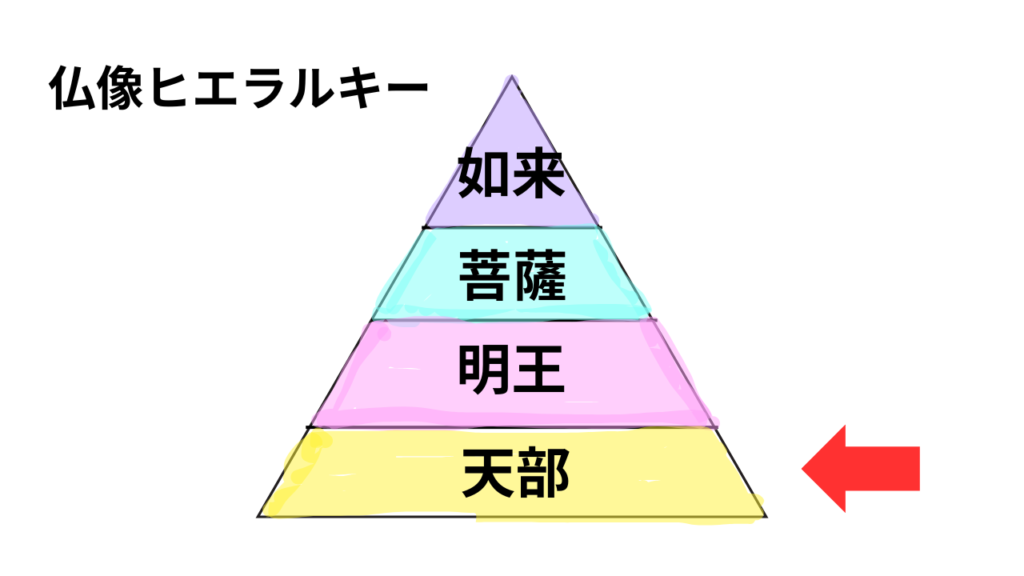
天部(てんぶ)について、もっと詳しく知りたい方はこちらの記事もぜひご覧ください。
▶︎守護神「天部」とは?|仏像の世界がより面白くなる基本知識と出会い方
仏像を見分ける 5つのチェックポイント
仏像を鑑賞するときに、次の5つに注目すると、種類の違いや仏が持つ意味が見えてきます。
- 持ち物やポーズ — 武器、蓮の花、楽器など所持品に注目
- 顔の表情 — やさしいか、怒っているか
- 服装の豪華さ — シンプルか、装飾が多いか
- 装飾や小物の有無 — 冠、宝珠、武具など
- 手の形(印相) — 手の形や指の形には深い意味がある
お釈迦さまとブッダは同一人物
お釈迦さまは「ゴータマ・シッダールタ」という実在の人物で、約2500年前にインドで仏教を開いた釈迦族の王子でした。彼が35歳で悟りを開いた後、「目覚めた者」「悟りを開いた人」という意味のサンスクリット語「ブッダ(buddha)」と呼ばれるようになりました。
「お釈迦さま」は尊称で、「釈迦族の尊い人」という意味です。「ブッダ」は本来「悟りを開いた者」を指す一般名詞ですが、仏教では特にお釈迦さまを指して使われるのが一般的です。
まとめ|実際に会いに行きましょう
仏像は種類によって姿も意味も異なります。
ほとけ様は、もともとお釈迦さまのことでしたが、仏教がインドから各国へ伝来していく途中で、仲間を増やしていきました。
人にはそれぞれ悩みや苦しみがあり、願いごとも全て違います。こうしたあらゆる人びとの、あらゆる願いを聞き入れるため、各分野の仏さまが必要になったのです。(八百万の神✨)
なかには、その土地で信仰されていた神さまが、仏教に取り入れられた例もあります。
- 仏像は大きく「如来」「菩薩」「明王」「天部」の4タイプ
- 服装・表情・持ち物・手の形などで見分けられる
- 種類を知ることで、鑑賞が楽しく、意味深くなる
仏像巡りは、知れば知るほど深く、心が整う旅になります。
次にお寺に行くときは、この「見分けポイント」で、仏像を見てください。きっと“出会いの深さ”を味わえるはずです 😊
仏像をもっと知りたい方へ|関連記事
▶︎如来とは?釈迦如来・薬師如来・阿弥陀如来・大日如来の違い
▶︎菩薩とは?|その意味や如来との違い、仏像の魅力をやさしく解説
▶︎守護神「天部」とは?|仏像の世界がより面白くなる基本知識と出会い方
おわりに|仏像を通して心にふれる時間を
仏像の世界は、本当に、奥深くて、美しくて、人の心に静かに響くものだと思います。
そこには、言葉にしきれない感動や、目の前の仏像から伝わってくる優しさ、強さ、そして静けさがあります。
それを理解できる人は少ないかもしれないけれど、私が発信し続けることで、「なんかいいかも」って思ってくれる人が、きっと少しずつ増えていくーーー
仏像の魅力を、もっともっと、世の中に伝えていけますように🙏✨
そんな思いを込めて、このブログを書いています😊
